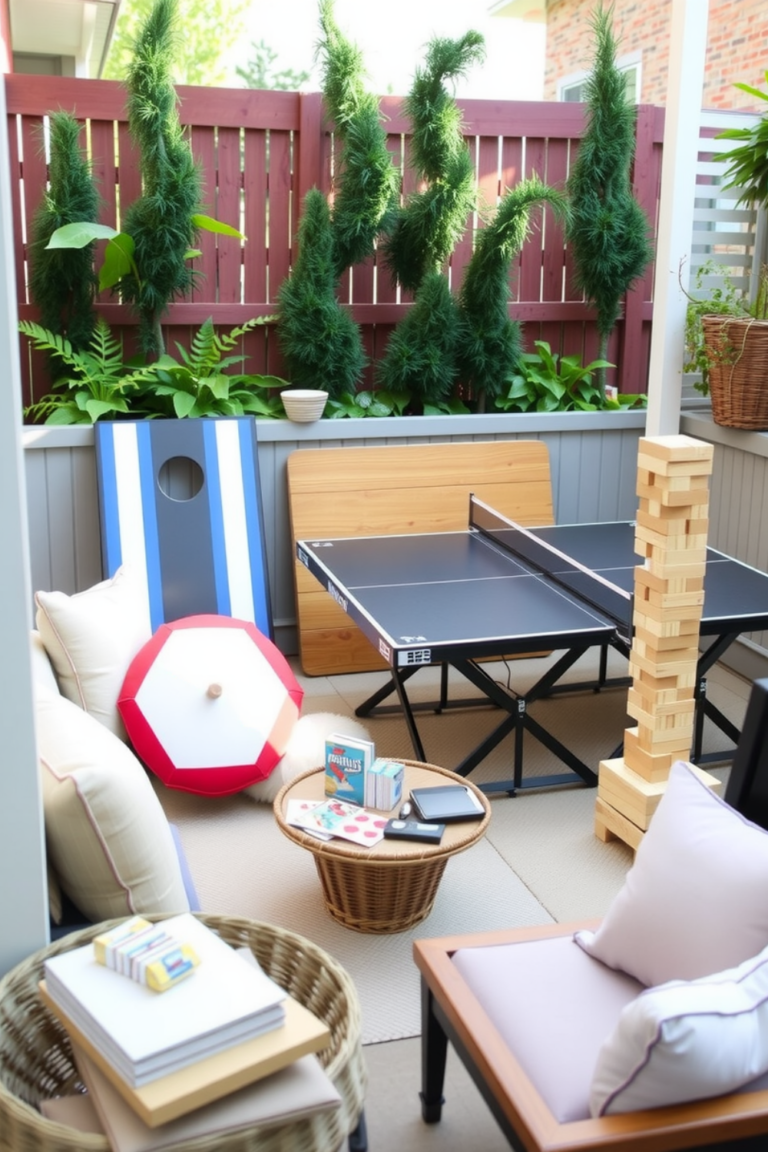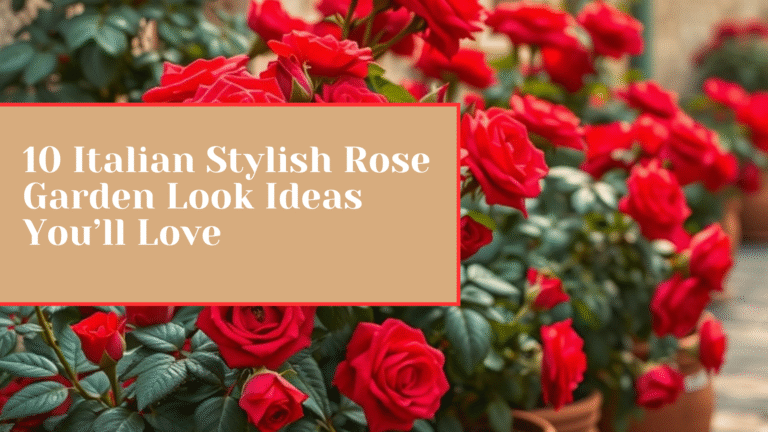14+ Spring Garden Ideas to Revitalize Your Outdoor Space
Spring is a season of renewal and growth, and what better way to embrace it than by breathing new life into your garden? From my own personal experience, I can tell you that there’s no better feeling than stepping into a beautifully transformed outdoor space. What ever you need , even if you’re an experienced gardener or just starting out, these top spring garden ideas will inspire you to get creative and make the most out of the season.
Let me show you how I make the most of spring gardening, with simple, practical tips and ideas that are easy to implement in your own backyard. Let’s jump in.
1. Create a Colorful Flower Bed for Vibrancy and Life

Spring is all about color, and what better way to bring it into your garden than with a vibrant flower bed? This idea is especially great if you love watching the garden come to life as the flowers bloom, giving you an ongoing display of natural beauty throughout the season.
Selecting the Right Flowers
When choosing flowers, focus on varieties that thrive in spring and can handle cooler temperatures. Some great options include tulips, daffodils, hyacinths, and crocuses. These flowers bring bold, cheerful colors to any garden. Personally, I love adding a mix of warm tones like yellow, red, and orange to brighten up the space. However, don’t forget about pastel-colored flowers like lavender or light pink roses to create a softer, more tranquil feel.
Tips for Success
To get the best results, make sure you plant your flowers in well-drained soil with plenty of sunlight. Flowers like tulips and daffodils need at least six hours of sunlight per day to thrive. Additionally, it’s important to space them appropriately so that they have room to grow and bloom without overcrowding each other.
Maintenance Tips
As the flowers grow, make sure to deadhead spent blooms regularly. This encourages more blooms and keeps the plants looking neat and tidy. Also, don’t forget to water them consistently but avoid overwatering, as it can cause root rot.
2. Design a Raised Garden Bed for Herbs and Veggies

If you’ve ever considered growing your own food, spring is the perfect time to get started. A raised garden bed is a simple, effective way to grow herbs, vegetables, and even small fruits like strawberries or raspberries. Not only will you have fresh, home-grown produce at your fingertips, but it also helps with weed control and improves drainage for your plants.
Building Your Raised Bed
From my own personal experience, building a raised garden bed is a rewarding project that doesn’t take much time. You can use wood, bricks, or even recycled materials to construct the bed. The ideal height for a raised bed is around 12 to 24 inches, making it easier to plant, tend to, and harvest your crops. Once you’ve decided on the size, line the bottom with landscaping fabric to keep weeds from infiltrating.
Choosing Plants for Your Raised Bed
When selecting plants, go for ones that are easy to grow in the spring and have a quick growing cycle. Lettuce, spinach, radishes, and peas are perfect spring crops, and they can even be grown together in the same raised bed. For herbs, basil, parsley, thyme, and mint are excellent choices that thrive in the spring sun. You’ll love the convenience of having fresh herbs right outside your door, ready for cooking.
Soil Tips for Raised Beds
Make sure you use high-quality soil in your raised bed. I recommend a mix of garden soil, compost, and peat moss to ensure good fertility and drainage. You may need to replenish the soil with organic matter each season, but it’s well worth the effort for healthy, productive plants.
3. Set Up a Cozy Outdoor Sitting Area
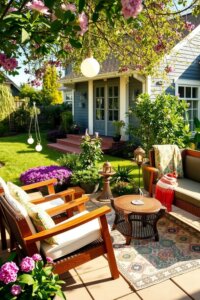
While gardening is about growing plants, it’s also about creating a space that you can relax in and enjoy. A cozy outdoor sitting area makes a perfect spot for sipping your morning coffee or reading a book while surrounded by your blooming flowers. This idea is all about adding comfort and functionality to your garden.
Choosing the Right Location
Pick a sunny spot in your garden where you can enjoy the warmth of the spring sun but also have some shade when it gets too hot. A nice balance of sunlight and shade will allow you to spend more time outside without being overwhelmed by heat.
Adding Comfortable Furniture
When it comes to furniture, think about comfort and style. I suggest adding a comfortable lounge chair or a small bench. If you have space, a hammock or a swing chair can be a fun and relaxing addition. Opt for weather-resistant materials like teak or wicker for durability and low maintenance. To make the space feel even more inviting, throw in some outdoor cushions or a colorful rug that complements the colors in your garden.
Lighting for Ambiance
To make your outdoor sitting area even more magical, consider adding lighting. Fairy lights, lanterns, or solar-powered garden lights can create a warm and inviting atmosphere as the sun sets. Lighting not only adds beauty but also allows you to enjoy your garden well into the evening.
Optional Extra: Add a Water Feature for Relaxing Sounds
If you want to elevate your garden even further, consider adding a small water feature. Whether it’s a fountain, pond, or even a birdbath, the sound of running water can bring a soothing and peaceful atmosphere to your garden.
Choosing the Right Water Feature
If you’re limited on space, a small tabletop fountain can be just as effective as a large pond. From my own personal experience, a water feature adds a calming effect, making it a perfect addition to your cozy outdoor sitting area.
Maintaining Your Water Feature
To keep your water feature clean and functioning, make sure to regularly change the water and clean the pump. If you have a pond, consider adding water plants like lilies to help with water clarity and attract beneficial wildlife.
4. Build a Vertical Garden for Small Spaces

Not everyone has a large backyard to work with, but that doesn’t mean you can’t have a flourishing garden. Vertical gardens are a perfect solution for small spaces, such as apartment balconies or narrow yards. These gardens allow you to grow plants upwards, utilizing your space efficiently and adding a touch of greenery to your outdoor area.
Choosing the Right Plants for Vertical Gardens
The beauty of a vertical garden is that it can support a wide variety of plants. From my own personal experience, I’ve found that climbing plants like ivy, morning glories, and cucumbers are excellent for vertical gardens. These plants naturally grow upwards and will give your garden a lush, cascading effect. If you’re looking to add a bit of color, consider planting flowers like petunias or sweet peas, which not only climb but also bloom beautifully.
Building Your Vertical Garden
Building a vertical garden can be as simple as installing a trellis against a wall or using a repurposed wooden pallet. If you want to get creative, there are also vertical garden towers or hanging planters that can hold a variety of plants. You can even repurpose old wooden crates or wine racks for a rustic look. Just make sure whatever structure you choose has plenty of support for the plants to climb.
Maintenance Tips
Since vertical gardens often use pots or containers, ensure your plants are getting enough water. Be mindful of drainage to avoid water buildup, which can cause root rot. Also, don’t forget to periodically prune your climbing plants to encourage healthy growth and prevent them from becoming too unruly.
5. Create a Butterfly Garden to Attract Pollinators
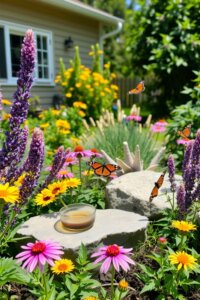
If you want to add life and movement to your garden, a butterfly garden is the way to go. Butterflies are not only beautiful to watch, but they also play an essential role in pollinating your plants. Creating a butterfly-friendly garden will help the local ecosystem while giving you a lovely display of colorful insects.
Choosing Plants That Attract Butterflies
Butterflies are drawn to specific plants that provide nectar, such as lavender, coneflowers, and butterfly bush. These plants are not only beautiful but also perfect for attracting various species of butterflies. From my own personal experience, I’ve had great success with adding milkweed to my garden, as it attracts monarch butterflies, which are a favorite among many gardeners.
Creating the Ideal Habitat
In addition to the right plants, butterflies also need a place to rest and lay their eggs. Include a few flat rocks in your garden where butterflies can bask in the sun. You can also add a shallow dish of water to provide a drinking source. If you’re feeling creative, you could even build a small butterfly house to give them a safe place to nest.
Maintenance Tips
A butterfly garden doesn’t require too much upkeep, but it’s important to avoid using pesticides that could harm the insects. Keep the flowers well-watered, and periodically deadhead the blooms to encourage new growth. By creating a welcoming environment for butterflies, you’ll enjoy their presence throughout the season.
6. Create a Natural Privacy Screen with Evergreen Shrubs

If you want to add some privacy to your garden without the need for fences or walls, evergreen shrubs are a fantastic solution. These plants maintain their foliage year-round, offering you a natural barrier that will keep your outdoor space private and serene.
Choosing the Right Evergreen Shrubs
When selecting evergreen shrubs, look for varieties that will thrive in your climate and soil. Some of the best options for privacy screens are boxwoods, arborvitae, and hollies. These shrubs grow tall and dense, making them ideal for blocking out unwanted views. From my own personal experience, I’ve found that arborvitae grows quickly and can form a thick, lush screen in just a few seasons.
Planting and Spacing Tips
To create an effective privacy screen, plant your shrubs in a row with enough space for them to grow without crowding each other. Be mindful of the mature size of each plant when planning the spacing. For a quicker result, consider using larger specimens to start with. Water them regularly, especially during the first few months after planting, to help them establish strong roots.
Pruning and Maintenance
Once your evergreen shrubs have grown, prune them occasionally to maintain their shape and encourage dense growth. If they start to become too tall or wide for your space, trim them back in late winter or early spring before new growth begins. These shrubs will continue to provide privacy and beauty for years to come.
7. Start a Spring Wildflower Meadow for Low-Maintenance Beauty
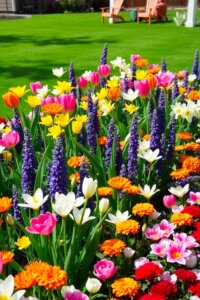
If you’re looking for a natural, low-maintenance garden, a spring wildflower meadow could be exactly what you need. This idea is perfect for those who love the beauty of a more organic, carefree garden. Wildflowers not only look beautiful but also provide valuable habitat for bees, butterflies, and other pollinators.
Choosing Wildflowers for Your Meadow
When selecting wildflowers, opt for native species that are well-suited to your region’s climate. Native wildflowers require less maintenance and are more likely to thrive without the need for constant attention. Some excellent choices include black-eyed susans, poppies, and lupines. From my own personal experience, I’ve noticed that planting a mix of colors and textures creates a vibrant, diverse landscape that looks stunning.
Preparing Your Space
To start your wildflower meadow, choose a sunny area with well-drained soil. You can either sow seeds directly into the ground or plant young wildflower plants if you prefer a quicker result. It’s important to clear the area of weeds and grass before planting to ensure your wildflowers have room to grow.
Maintenance Tips
Once your wildflower meadow is established, it requires very little maintenance. During the growing season, keep the soil moist but avoid overwatering. After the flowers bloom and go to seed, mow the area in late fall to prevent the growth of invasive weeds. The natural beauty of a wildflower meadow will thrive on minimal interference and provide a stunning view all season long.
8. Design a Relaxing Zen Garden for Tranquility
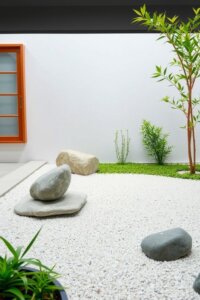
If you’re looking for a peaceful and meditative space in your garden, a Zen garden could be just what you need. Zen gardens are minimalist and focus on simplicity and tranquility, making them perfect for creating a calm retreat in your own backyard.
Choosing the Right Elements
Zen gardens typically feature elements like rocks, sand, and a few carefully chosen plants. For the best effect, choose rocks with interesting textures and shapes that you can arrange in a way that feels balanced. You can also add a small water feature, such as a fountain or pond, for a soothing sound. From my own personal experience, a small bamboo plant or a simple bonsai tree can be a beautiful touch to complete the Zen aesthetic.
Creating the Layout
Start by selecting a quiet, secluded part of your garden to create the Zen garden. Clear the space of any debris and lay down a base layer of sand or gravel. Arrange your rocks, and if you’re adding plants, place them thoughtfully in the corners or edges of the garden to maintain a sense of openness and simplicity. You can also use a small rake to create patterns in the sand, mimicking the flow of water.
Maintaining Your Zen Garden
A Zen garden is relatively low maintenance but does require periodic upkeep. Keep the sand smooth and raked, and occasionally clear any weeds or debris from the garden. If you’ve included plants, be sure to water them according to their needs, and prune them to maintain the serene atmosphere. The key to a Zen garden is its calm, uncluttered nature, so less is often more.
9. Start a Herb Garden for Fresh Flavors
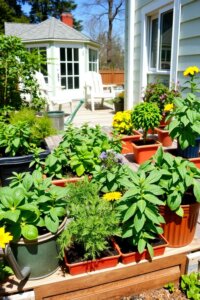
A spring herb garden is a fantastic way to elevate your cooking with fresh, homegrown ingredients. Not only do herbs add flavor to your meals, but they also thrive in the warmer months, making them perfect for a spring garden project. Plus, they’re easy to grow, even in small spaces.
Choosing the Best Herbs for Spring
When starting an herb garden, it’s essential to choose herbs that are well-suited for the spring climate. Popular options include basil, thyme, rosemary, parsley, and mint. From my own personal experience, I find that basil and parsley are the easiest to grow and add the most flavor to a wide variety of dishes. You can also experiment with more exotic herbs like cilantro or oregano, depending on your preferences.
Planting Your Herb Garden
You can grow herbs in the ground, in containers, or even in hanging baskets. If you’re short on space, container gardening is a great option. Just make sure your herbs get plenty of sunlight (most herbs need 6-8 hours a day). For a raised bed or container garden, use well-draining soil, and ensure you water the plants regularly but avoid overwatering.
Harvesting and Using Fresh Herbs
To get the most flavor from your herbs, try to harvest them in the morning when the oils are at their most potent. Cut the herbs just above a leaf node to encourage new growth. You can use fresh herbs immediately in cooking, or if you have a surplus, try drying them for later use. From my own personal experience, there’s nothing like the taste of freshly harvested basil in a homemade pasta sauce, it makes all the difference.
10. Build a Raised Bed Garden for Easy Planting
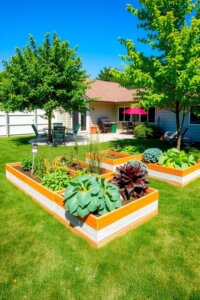
If you have poor soil or just want a more organized way to grow plants, a raised bed garden could be the perfect solution. Raised beds are essentially planting areas elevated above the ground, which improves drainage, reduces weed growth, and makes gardening easier on your back.
Building Your Raised Bed
Creating a raised bed is relatively simple. You can build one with wood, brick, or even concrete blocks. From my own personal experience, I’ve found wooden frames work best because they are easy to build and look aesthetically pleasing in most gardens. Make sure the bed is at least 6-8 inches deep to allow roots to grow properly. Fill it with nutrient-rich soil, compost, and a mix of organic matter for optimal plant growth.
Choosing What to Plant
A raised bed is perfect for vegetables, herbs, and even flowers. Depending on the size of your bed, you can plant a variety of crops such as tomatoes, carrots, lettuce, and beans. To get the most out of your raised bed, try companion planting. For example, basil and tomatoes grow well together and can help improve each other’s growth. Be sure to plan your planting layout so that taller plants don’t overshadow smaller ones.
Maintenance and Care
Raised beds require minimal maintenance. Water regularly, especially during dry spells, and make sure the soil doesn’t dry out completely. Also, keep an eye out for pests, especially if you’re growing vegetables. If you notice any pests, try natural remedies like neem oil or insecticidal soap. Raised beds are also easier to manage for weed control because the soil is elevated and less prone to weed growth.
11. Set Up a Spring Vegetable Garden for Fresh, Homegrown Produce
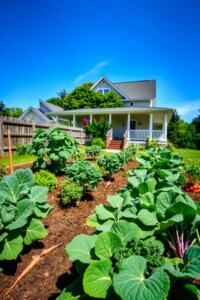
If you’re ready to take your gardening to the next level, consider starting a vegetable garden this spring. Growing your own vegetables is a rewarding experience, and it allows you to enjoy fresh, homegrown produce throughout the season. Whether you’re an experienced gardener or just starting, growing vegetables can be easy and fun.
Choosing the Right Vegetables for Spring
Spring is the perfect time to plant cool-weather crops like spinach, lettuce, peas, radishes, and carrots. From my own personal experience, I’ve had great success with growing leafy greens like kale and Swiss chard, as they thrive in the early spring months. You can also plant potatoes, onions, and broccoli once the weather warms up a bit.
Preparing the Soil
Before you plant, it’s important to prepare the soil. Start by clearing any weeds and adding compost or organic matter to enrich the soil. You can test the soil’s pH to ensure it’s ideal for vegetable growth (most vegetables prefer slightly acidic to neutral soil). Once your soil is prepared, plant your vegetables according to their recommended spacing, and make sure they get enough sunlight.
Harvesting Your Vegetables
Once your vegetables are ready to harvest, be sure to pick them at the right time for the best flavor. Leafy greens should be harvested young for the tenderest leaves, while root vegetables like carrots and radishes should be pulled when they’re mature. Harvesting regularly encourages your plants to keep producing throughout the season.
12. Create a Vibrant Flower Garden with Seasonal Blooms
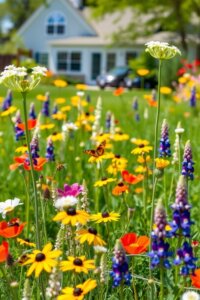
If you want your garden to burst with color this spring, creating a vibrant flower garden is the way to go. Spring is the perfect time to plant flowers that will thrive in the warmer months, and nothing beats the sight of colorful blooms.
Choosing the Right Flowers for Spring
To create a vibrant flower garden, start by selecting flowers that bloom in spring and early summer. Some great options include tulips, daffodils, crocuses, and hyacinths. From my own personal experience, I love planting a mix of perennials and annuals. Perennials, like peonies and lavender, will come back year after year, while annuals, such as petunias and marigolds, give you a burst of color all season long.
Planting Your Flowers
Start by planning the layout of your flower garden. Consider the height of your plants and place taller ones toward the back and shorter ones in the front to create layers of color. For the best results, make sure the flowers you choose are suited to your garden’s soil type and the amount of sunlight it receives. Flowers generally love full sun, but some varieties, like begonias, do better in partial shade.
Caring for Your Flower Garden
Once your flowers are planted, make sure they get regular water, especially during dry spells. Deadhead the flowers as they begin to fade to encourage new blooms and prevent your garden from looking messy. Also, be mindful of pests, as flowers can attract insects. If you notice pests, try natural remedies like neem oil or companion planting to deter them. Watching your flowers bloom over time is one of the most rewarding parts of gardening.
13. Design a Garden for Wildlife and Pollinators
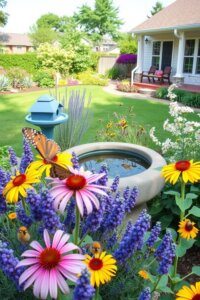
A wildlife-friendly garden is a fantastic way to attract beneficial creatures like birds, bees, and butterflies into your space. By creating an environment that supports pollinators, you’re not only enhancing your garden’s beauty but also supporting the ecosystem.
Choosing Plants that Attract Wildlife
To design a wildlife-friendly garden, start by choosing plants that attract pollinators. Flowers like lavender, sunflowers, and echinacea are all great options. Bees especially love purple, blue, and yellow flowers. From my own personal experience, I’ve noticed that plants like bee balm and coneflower are fantastic for attracting pollinators. For a bird-friendly garden, include native shrubs like holly and elderberry, which provide berries and shelter for local birds.
Creating a Habitat for Wildlife
In addition to planting the right plants, you can also provide shelter for wildlife. Consider adding a birdbath or small pond to your garden to create a water source for animals. Installing a birdhouse or nesting box will also encourage birds to visit. If you have the space, you might also want to create a small wildflower meadow to attract more diverse wildlife.
Maintaining Your Wildlife Garden
A wildlife garden requires a bit of patience, but it’s well worth it. Keep an eye out for signs of visitors, like bird nests or bee activity. From my own personal experience, it’s important to avoid using chemical pesticides in a wildlife garden, as they can harm beneficial insects. Instead, try organic or natural pest control methods like introducing ladybugs or using companion planting.
14. Set Up a DIY Composting Station for Sustainable Gardening
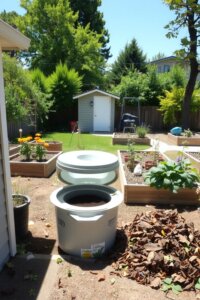
Composting is one of the easiest and most effective ways to make your garden more sustainable. It reduces waste, improves soil quality, and is environmentally friendly. Plus, it’s a fantastic way to make your garden even greener and healthier.
Getting Started with Composting
To begin composting, you’ll need a compost bin or pile. You can either buy a compost bin or create your own by piling organic matter in a corner of your yard. From my own personal experience, I find that a compost tumbler works best because it’s easy to turn and speeds up the decomposition process. Be sure to choose a spot that gets plenty of airflow and is close enough for easy access.
What to Add to Your Compost
You can compost many organic materials, such as fruit and vegetable scraps, coffee grounds, grass clippings, leaves, and small twigs. Try to keep a balance between “greens” (nitrogen-rich materials) like vegetable scraps and “browns” (carbon-rich materials) like dry leaves or cardboard. It’s important to avoid composting meat, dairy, and oily foods, as they can attract pests.
Maintaining Your Compost
To keep your compost healthy, turn it regularly to aerate the mixture and speed up the decomposition process. Make sure your compost is moist but not too wet, and check it every couple of weeks to ensure it’s breaking down properly. Over time, your compost will turn into rich, dark soil that can be used to fertilize your garden and improve plant growth. From my own personal experience, composting has been an incredible way to reduce waste and create nutrient-rich soil that supports vibrant plants.
Closing Thoughts
With these spring garden ideas, you have plenty of ways to refresh your garden space and make it a place you’ll love spending time in. Whether you’re creating a vibrant flower garden, attracting wildlife, or composting to make your garden more sustainable, the possibilities are endless. From my own personal experience, I can tell you that gardening is not just about growing plants, it’s about creating a space that reflects your style and brings you joy.
If you’ve tried any of these garden ideas or have your own to share, feel free to leave a comment below. I’d love to hear how your garden is coming along and what you’ve been planting this season. Happy gardening, and enjoy the beautiful spring weather.

I’m Gemma, a passionate lifestyle blogger sharing my creative world with you. Gemitaliano.com is my little corner of the internet, glad you’re here.






